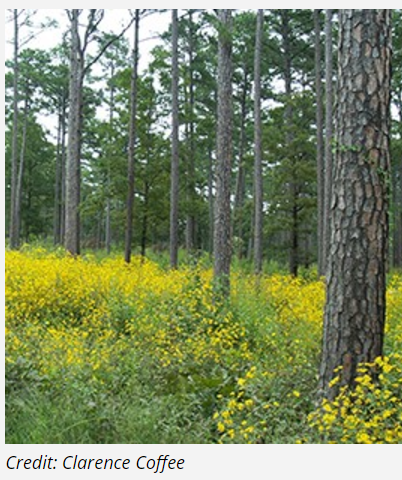|
Woodland Owner Notes E-news
|

Interested in Shortleaf Pine?
The Shortleaf Pine Initiative (SPI) was created in 2013 by a broad range of public and private organizations, and various state and federal agencies working in the shortleaf pine ecosystems in the USA. Shortleaf pine forests and associated habitats once covered a vast area of the continent stretching from eastern Texas and Oklahoma to the eastern seaboard from New Jersey down to Florida, in total, 22 states. The SPI website is a source of information and action ideas that can improve and restore shortleaf pine (
Pinus echinata) and the many ecological and economic benefits of the species.
 Landowners in North Carolina's Piedmont and foothills region may be interest in some of the upcoming events that are listed on the SPI website at:
|
What is a "Ghost Forest"?
You have likely seen a ghost forest at some point here in North Carolina, but they are found in many areas of the USA.
In lowlands, a change in the hydrology of a forested area can come from a variety of sources including natural disasters resulting from hurricanes or floods. When the water recedes most of the species will return to their normal vigor. However, when a forested area's natural hydrology makes a long term change some trees and plants may limp along for several growing seasons, but other plants, better adapted to wet conditions, will begin to populate the area.
|
|
 |
|
Evans County Georgia. Courtesy of Dr. Kevin Potter, NC State University, Department of Forestry and Environmental Resources
|
 |
Rapidly invading insects and diseases, such as laurel wilt, hemlock woolly adelgid or balsam woolly adelgid, might be the the root cause of the loss of large areas of woodlands in many parts of North Carolina. When trees are under stress from long-term dryer or hotter weather, they may succumb and die. What remains is a rather 'ghostly' site.
Research done by Dr. Kevin Potter of NC State University, Department of Forestry and Environmental Resources, identifies the most vulnerable species when these significant changes in environmental conditions occur. "We are now working on a separate analysis of tree species vulnerability to pests and pathogens, which is arguably a more immediate threat than climate change because of the speed at which insects and disease can kill their hosts and decimate populations. At the end of the project, we will combine the two analyses to identify the species that have the highest overall vulnerability to these two threats."
You can read more about this research project in the May 2017 edition of the CompassLive newsletter, USDA Forest Service Southern Research Station.
|
Noteworthy Extension Forestry Publications
Available to download, print and share - just click the title and read on.
The forest economy supports communities in every county of North Carolina. Industrial demand incentivizes forest stewardship, which improves environmental diversity, forest health, wildlife habitat, recreational opportunities, and the potential for landowners to receive future timber incomes. Consequently, soils are stabilized, both water and air are filtered, while carbon is sequestered.

Most of North Carolina's forest land is owned by private landowners. Many of these landowners will only sell timber once or twice in their lifetime. Selling assets such as timber, homes, land, etc. should be done with a legal contract. Landowners should always use a solid written contract or timber deed when selling timber - as an added precaution it should be recorded at a courthouse. A well-executed contract or deed can avoid any misunderstandings between owners and buyers.
Hardwood lumber's nature as a producer good piques interests in its price across the forest value chain. Secondary manufacturers are keenly aware of their raw material costs. The margin present between kiln-dried and green lumber prices can provide insights into the economics of the drying process.
The prices received by sawmillers represent the fixed and variable costs incurred to convert standing hardwood sawtimber into lumber, along with some provisions for profits and risk along each step of the process. Five year trends can provide forest landowners an understanding of the hardwood production cycle when considering a timber sale.
|
Coming Events of Interest to Woodland Owners
September 16, 2017,
8 am to 1 pm
-
Tree Farm Breakfast and Tour
at Preston Floyd's farm in Kittrell, NC. Contact Leslie McCormick to register at
[email protected]
October 14, 2017 - NC Tree Farm Program 2017 Annual Meeting, Wagram, NC
The annual meeting will include a field tour focusing on wildlife management. More details coming next month.
Looking Ahead - Please save the date!
October 25, 2017,
6-8 pm - Onslow County Present Use Value Meeting, Jacksonville, NC
November 2, 2017 - Johnston County Forestry Meeting - Smithfield, NC
(details coming).
This is a 1-1/2 day symposium plus full day field tour for those interested in managing forestland in swamp and bottomland areas of the Southeastern USA. Sponsored by NC Forest Service.
November 1, 2017 - Franklin County Forestry Meeting and Tour (details coming).
November 2, 2017 - Johnston County Forestry Meeting - Smithfield, NC (details coming).
November 16, 2017 - Hoke County Forestry Meeting - 5 pm - Raeford, NC (details coming).
|

If you received this email as a
forwarded message,
and like what you see,
please use this handy
button to join the mailing list.
|
Woodland Owner Notes E-news is an email newsletter from Extension Forestry at NC State University. This newsletter is made possible through support from Renewable Resources Extension Act and the National Institute of Food and Agriculture. The 2017 editors are:
Mary Lou Addor, NC State University, Sentinel Landscapes Project, Raleigh, NC
Jim Hamilton, NC Cooperative Extension Service, Asheville, NC
Alton Perry, Roanoke Electric Cooperative, Roanoke Rapids, NC
Colby Lambert, NC Cooperative Extension, Lillington, NC
Robert Bardon, NC State University, Extension Forestry, Raleigh, NC
Send Comments to:
Kelley McCarter, at
NC State University, PH: 919-515-9563
|
|
|
|
|
|